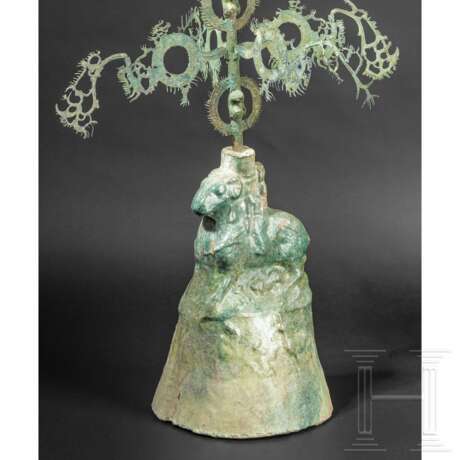ID 548549
Lot 391 | Geldschüttelbaum, Yao-quian-shu, China, östliche Han-Dynastie, 25 bis 220 n. Chr.
Estimate value
€ 39 000
Grünlich patinierte Bronze, teilweise äußerst filigran gearbeitet, und glasierte Keramik. Den kegelförmigen Fuß mit grüner Bleiglasur ziert ein Reiter auf einem Widder. Der Stamm ist gegliedert durch fein geflammte Sonnenringe, welche jeweils einen kleinen Bären umschließen. Vier Reihen von filigranen Ästen mit Tieren, Fabelwesen und Münzen stecken im Stamm, die Spitze ist ähnlich gestaltet. Der im Geäst vorhandene Geldsegen hat zwar für die Bezeichnung "Geldschüttelbaum" gesorgt, kommt aber nicht in erster Linie dem Verstorbenen im Jenseits zugute, sondern bildet ein Opfer an die Götter. Die daoistische Götterwelt ist in diesen Bäumen dargestellt durch Xiwangmu, die Königin-Mutter des Westens in ihrem Paradies. Geldschüttelbäume sind sehr selten und nur aus dem Südwesten Chinas bekannt. Ein Thermolumineszenz-Test vom Labor Kotalla aus dem Jahr 2000 bestätigt die Datierung. Altersschäden, teils restauriert. Originale Patina. Höhe ca. 135 cm.
Provenienz: Deutsche Privatsammlung, angeblich auf E.A. Voretzsch zurückgehend, der 1924 über Bronzen publizierte. Für eine eingehende Erörterung dieser Geldbäume siehe “Orientations“, September 1997, S. 67-84.
Zustand: II -
A Chinese money-shaking tree, yao qian shu, Eastern Han Dynasty, 25 to 220 A.D.
Greenish patinated bronze, intricately worked in places, and glazed ceramic. A rider on a ram adorns the conical base with green lead glaze. The trunk is composed of solar rings with finely flamed coronae, each encircling a small bear. The trunk extending into four rows of delicate branches with animals, mythical creatures and coins, the tip similarly structured. Although the coins in the branches gave rise to the name of the "money-shaking tree", their primary purpose is not to ensure the prosperity of the dead in the afterlife, but to serve as an offering to the gods. Taoist mythology is represented in these trees by Xiwangmu, the Queen Mother of the West in her paradise. Money-shaking trees are extremely rare and known to derive only from South West China.
A thermoluminescence expertise prepared by the Kotalla laboratory in 2000 confirms the date. Height approx. 135 cm.
Provenance: German private collection, supposedly going back to E.A. Voretzsch, who published on bronzes in 1924. For an in-depth discussion of these money trees, see "Orientations", September 1997, pp. 67-84.
Condition: II -
| Address of auction |
Hermann Historica Bretonischer Ring 3 85630 Grasbrunn / München Germany | ||||||||||||||
|---|---|---|---|---|---|---|---|---|---|---|---|---|---|---|---|
| Preview |
| ||||||||||||||
| Phone | +49 (0)89 5472 649 0 | ||||||||||||||
| Fax | +49 (0)89 5472 64999 | ||||||||||||||
| Buyer Premium | 25 % | ||||||||||||||
| Conditions of purchase | Conditions of purchase | ||||||||||||||
| Business hours | Business hours
|






